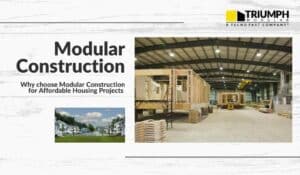Over the years, modular construction has grown from a niche market to a genuine alternative to traditional construction.
We’re at the point where modular provides many benefits over traditional—including sustainability.
Traditional construction methods currently lag behind when it comes to sustainability. Below, we’ll highlight three sustainability factors in construction and how the modular approach can help.
Waste Reduction
It’s no secret that the construction industry creates a lot of waste. With traditional construction methods, this problem doesn’t seem to be improving, either—by 2025, waste volume is expected to reach 2.2 billion tons.
A significant portion of this waste comes from material waste. Traditional construction sites produce staggering amounts of material waste without precision in material usage or re-usage. This waste is caused by everything from material damage to building errors.
The entire premise with modular construction involves off-site building in a controlled factory environment. With modular, you get better inventory control, less accidental damage to materials, and the ability to reuse materials in future projects instead of throwing unused materials into landfills.
Waste reduction is one of the most important aspects to consider when creating sustainable construction methods, and modular is leading the charge.
Reusability
Do you know what else creates a significant amount of waste?
Building demolitions.
Many buildings are demolished when they no longer have a use, contributing further to our ongoing construction waste problem. In fact, an estimated one-quarter of the US waste stream is caused by construction debris.
Instead, why don’t we use buildings that are easily repurposed or, at the very least, taken down without creating demolition waste?
Not only does modular construction reduce waste during the construction process, but it also keeps waste to a minimum by offering easily relocatable and reusable buildings. We all know the importance of “reduce, reuse, and recycle,” right?
Many modular buildings can serve several purposes during their service life. For example, with our Belmont Hill School project— the school needed additional swing space, and Triumph Modular met their demands by repurposing buildings within our fleet!
If deconstruction is necessary, modular buildings create negligible waste—especially compared to traditional demolition sites. This reusability also means no more new materials are used, further reducing the environmental impact.
Finally, most modular buildings allow simple modification, extension, or alteration with minimal site impact. Compare this to traditional construction, where the expansion of space creates even more waste.
Lower Emissions
Since everything is done on-site, large machines and equipment need transportation to the site, which releases significant carbon emissions.
Recently, Triumph Modular’s CEO, Joseph Vecchiolla, participated in a panel discussion at ChileMass. He noted that the construction industry is responsible for 38% of greenhouse gas emissions caused by the raw manufacturing of construction materials, on-site work, and construction debris.
Now, let’s compare this to modular construction. With everything built off-site, there’s no need to transport larger equipment and machines—everything is already at the factory. The building itself will need to be transported to the site, but this results in a much smaller amount of emissions when compared to the multiple machines necessary for a traditional construction site. The construction timeline with modular is reduced by 50%, and the process reduces activity on the worksite by up to 90%.
Looking For More Info On Sustainability in Modular Construction?
As champions of modular construction and with over 40 years in the industry, we’re experts on sustainability in modular. If you want more information, check out our modular sustainability page, where you’ll find green building advantages, information on the LEED system, and more.




